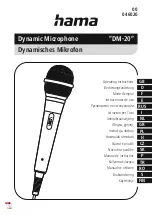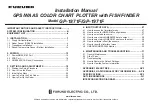
Ten Tips To Obtain The Best Results
Check the frequency of the system against the chart on page 7
to ensure you have the proper frequency for your area.
Operating frequency is shown on the back panel of the
receiver and on the transmitter.
Turn down the AF Level control of the receiver as well as
the mixer. Switch on the receiver only. Do
not
switch on the
transmitter yet.
Receiver On . . .
The power indicator will light up.
Transmitter On . . .
The transmitters have a 3-position power switch. When the
switch is set to “Standby,” the transmitter produces RF with no
audio signal. When the switch is “On,” the transmitter produces
both RF and audio.
Receiver Squelch
The squelch control on the back of the receiver is preset at the
factory, but can be adjusted if you must use the system in an
area with considerable RF interference. If there is audio output
from the receiver when
your
transmitter is
off,
adjust the
squelch control so the system will receive the signal from
your
transmitter but “squelch” or eliminate the unwanted
background RF noise. This adjustment can cause a reduction in
useable range of the wireless transmitter, so set the control to
the
lowest
position that reliably mutes the unwanted RF signals.
Input Level Adjustment
Input trimmer controls in the transmitters enable you to use
microphones or guitars with different sensitivities, or to adjust
for different acoustic levels.
Adjusting Input Levels – UniPak Transmitter
Slide the battery cover off the top part of transmitter and
remove the screwdriver from its clip (Fig. D). Gently turn the
“MT” (mic trimmer) and “GT” (guitar trimmer) controls to their
full counter-clockwise positions.
• Microphone: Adjusting input level
While speaking/singing into the microphone at typically-loud
levels, carefully turn the MT control clockwise while watching
the receiver's AF Level indicator. Increase the MT control set-
ting until the
maximum
audio output of the mic lights about
three or four LED units on the receiver's AF Level indicator.
Do not set the level too high (indicated by the red LED
lighting). At normal audio levels, only the first two or perhaps
three LEDs should light.
(When using a guitar, return the MT
control setting to minimum.)
• Guitar/Instrument: Adjusting input level
While playing at typically-loud levels, carefully turn the GT
control clockwise while watching the receiver's AF Level indi-
cator. Increase the GT control setting until the
maximum
audio output lights about three or four LED units on the
receiver's AF Level indicator. Do not set the level too high
(indicated by the red LED lighting). At normal audio levels,
only the first two or perhaps three LEDs should light.
(When
using a microphone, return the GT control setting to
minimum.)
After adjusting input levels, return the screwdriver to its clip
and reinstall the battery cover. No further transmitter gain
adjustments should be needed, as long as the input device
and the acoustic input level are not changed.
Adjusting Input Level – Handheld Transmitter
Unscrew the lower body cover and slide it downward, exposing
the screwdriver and gain trimmer (Fig. G). Remove the screw-
driver and
gently
turn the gain trimmer control to its full
counter-clockwise position.
While speaking/singing into the microphone at typically-loud
levels, carefully turn the trimmer control clockwise while
watching the receiver’s AF Level indicator. Increase the control
setting until the
maximum
audio output of the mic lights
about three or four LED units on the receiver's AF Level indi-
cator. Do not set the level too high (indicated by the red LED
lighting). At normal audio levels, only the first two or perhaps
three LEDs should light.
Return the screwdriver to its clip and close and secure the
lower body. (Make certain that the white “battery keeper”arm
is inside the body.) No further transmitter gain adjustments
should be needed, as long as the acoustic input does not
change significantly.
System Operation
1.
Use only fresh alkaline batteries. Do not use “general purpose”
(carbon-zinc) batteries.
2.
Position the receiver so that it has the fewest possible obstructions
between it and the normal location of the transmitter.
Line-of-sight is best.
3.
The transmitter and the receiver should be as close together as
conveniently possible, but no closer together than three feet.
4.
The receiver antennas should be in the open and away from
any metal.
5.
A receiver cannot receive signals from two transmitters at the
same time.
6.
In the UniPak transmitter, the “MT” or “GT” input control
not in
use should be set to
minimum.
7.
For best operation, all the RF Level LEDs should be lit (maximize
RF input); but only the first two or three AF Level LEDs should be
lit (don't overmodulate).
8.
If the AF Level control of the receiver is set too high, it may
over-drive the input of the mixer or clip the output of the receiver,
causing distortion. Conversely, if the receiver output is set too
low, the overall signal-to-noise ratio of the system may be reduced.
Adjust the output level of the receiver so the highest sound pressure
level going into the microphone (or the loudest instrument playing
level) causes no input overload in the mixer, and yet permits the
mixer level controls to operate in their “normal” range (not set
too high or too low). This provides the optimum signal-to-noise for
the entire system.
9.
Turn the transmitter off when not in use. Remove the battery if
the transmitter is not to be used for a period of time.
10. In multiple-system applications, set the battery-save switches
on Low if possible, to reduce the chance of intermodulation
problems.
CAUTION!
The small trimmer controls are
delicate;
use
only the supplied screwdriver. Do
not
force the trimmers
beyond their normal 180
o
range of rotation.
Return the screwdriver to its storage clip when not in use.
5


























